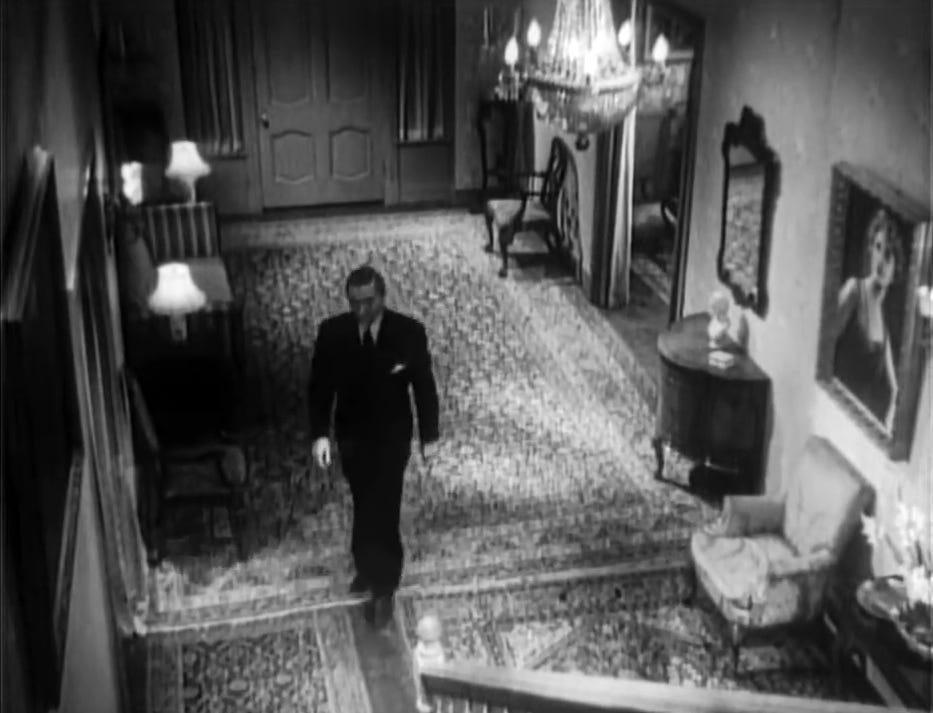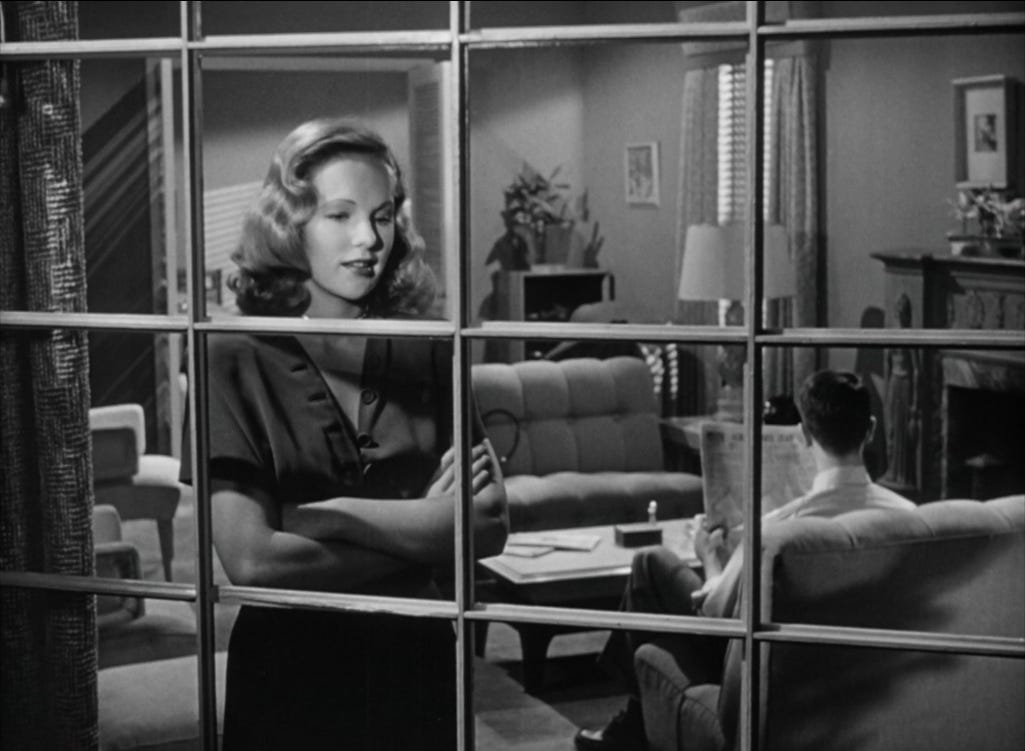During his years making low-budget westerns, Joseph H. Lewis was noted for introducing wagon wheels into his shots to give them some visual distinction, and he kept this as a signature throughout his filmography. So often his characters would be seen behind windows with sectional bars caging them in, and as his career went on, in late pictures like The Halliday Brand (1957) and Terror in a Texas Town (1958), his style had gotten so austere that some shots could pass for frames from the severest Ingmar Bergman movies.
Most Lewis enthusiasts come to his work first because of his most famous movie, the noir classic Gun Crazy (1950), with its lengthy hold-up scene done in an actual car by an actual bank. No one but the two principal actors, John Dall and Peggy Cummins, and the actors inside the bank were aware of what was happening, and Lewis kept this fresh by having the actors improvise some of their dialogue in order to keep the tension high.
The strange love story between Cummins’s dominating and psychotic Annie Laurie Starr and Dall’s Bart Tare was fleshed out by blacklisted screenwriter Dalton Trumbo, who was not given credit at the time for his work, and the very romantic musical score by Victor Young helps to make this picture as unsettling as it still is and always will be; is the lust for guns that Bart and Annie share a lust just for sex, or for something beyond sex?
Lewis’s style in Gun Crazy is very Expressionist, putting us into the state of mind of Bart and of Annie with extreme close-ups that cut them off from their surroundings and even sometimes from each other in moments of high stress. Cummins’s Annie is a sociopath; when she speaks of being “kicked around” and missing her father’s shooting gallery in Brighton, it is difficult to pin down what happened to her and what she thinks happened to her in her shut-down mind. Dall’s Bart has a streak of conscience, but even he realizes that Annie is giving voice to urges that he has somewhere deep down; she is like the devil on his shoulder urging him on, but there are moments when she is also like a demented little girl drawn to the worst sort of misbehavior, and where does that sort of thing come from?
Lewis’s point of view on humanity in his movies is very dark. A sweet-looking older lady like Dame May Whitty can turn out to be a cold character guarding over a psychotic son (George Macready) in his sleeper hit My Name Is Julia Ross (1945), a lean, plot-driven movie that was endlessly copied afterward. There are implausibilities as that picture goes on; this is a common weakness with plot-heavy films and especially those based around some sort of kidnapping where the victim has to keep trying to alert others or get away. But Lewis saw how dreamlike movies could be, and like his best work My Name Is Julia Ross plays like a dream, or a nightmare.
The son of Russian Jewish immigrants, Lewis grew up on the Upper East Side in New York and went out to Hollywood in 1927 at age 20 to work his way up, initially with hopes of becoming an actor, but then as a camera assistant and editor. He began directing his first movies, low budget westerns, in the late 1930s, but his talent was only fully revealed with Invisible Ghost (1941), a Bela Lugosi picture.
Invisible Ghost was made for Monogram, and it runs a little over an hour and takes place mainly in an old dark house. The script Lewis was given is absurdly improbable and convoluted, and yet, with the help of Lugosi, Clarence Muse, and Betty Compson, Lewis transforms this poor material with his visual ideas, patterns, and rhythms. Lugosi’s character has to kill whenever he sees his long-missing wife (Compson) through a window, and Lewis gets an enormous amount of tension and menace out of the repetition of shots, particularly of overhead shots from the top of the stairs of the house as Lugosi makes his trance-like descents. Muse also manages to transform his own butler role, which has some lame jokes that are supposed to be at his expense in the dialogue, by somehow finding plausible psychological motivation for why his character stays employed in this house. Like Lewis here, Muse manages to turn insulting dross into gold.
Lewis’s talent is also on display in Bombs Over Burma (1943), a vehicle for Anna May Wong where she plays a schoolteacher during wartime. In the first ten minutes of this movie, Wong’s character is always putting the class clown in a corner and making him wear a dunce cap when he acts up, and Wong makes it clear that she likes this little boy even if she feels the need to discipline him. There is an attack from overhead, and Wong rounds her children up to go downstairs to wait it out, but in the confusion she forgets about the little boy in the corner, who stays at a window and reacts with excitement to the planes dropping bombs, not understanding that the danger they pose is real.
Lewis builds the tension here and keeps cutting from the planes to the boy framed in the window and Wong coming back upstairs to try to rescue him. And then, just as we think she will succeed, the joyous little boy suddenly crumples near the window, his happy face pierced now by physical pain as he dies. This is one of the most upsetting sequences in American 1940s cinema, too often neglected because it is from a low-budget picture made for PRC. Like Bart in Gun Crazy, this little boy is drawn to guns and doesn’t understand the damage they can do.
Lewis is always thinking visually, and by the time he made Gun Crazy his shots had become fabulously self-sufficient, as if they didn’t need any other shots around them to make an impact. There are missteps in his work, particularly a tendency to do point-of-view shots from inside fireplaces, an inane visual idea that Hitchcock went out of his way to scorn in interviews, and he must have had some Lewis pictures in mind when he did so.
But even Hitchcock must have been impressed and alarmed by Annie Laurie Starr in Gun Crazy and her perverted, lascivious, sometimes empty face in close-ups: “I want action!” she cries, and she gets it. Annie and Bart are insane for each other, too, which is why Gun Crazy is a case study but also a romance, and maybe there is something positive in that somewhere, or at least better than nothing, the way an explosion might be better than nothing and empty waiting. Annie is a very bad person, and Bart goes down with her in this picture, but there is some understanding for her, or wonder, at least. “Laurie, no matter what happens, I wouldn’t have it any other way,” Bart tells her just before he has to shoot her, the way you have to shoot a wild animal before it attacks to kill (she was about to kill his friends).
Lewis’s style got far calmer and more distanced after the conflagration of Gun Crazy, the height of his career. He allowed cinematographer John Alton to experiment with shadows in all the long shots in The Big Combo (1955), where Lewis’s attention to perverse or suppressed or hidden sexuality was still keen. The Halliday Brand is so distanced and controlled visually that the control feels downright showy, but there were little flares of his 1940s-era intensity in his final feature Terror in a Texas Town before he moved into TV work, where his name in the credits meant that camera moves and a distinct visual vocabulary would be present no matter how short the shooting schedule.
Lewis retired in 1966, but he made it to age 93 in 2000, and in all those years he was an enthusiastic spokesman for his films and for films in general, and both Lewis and his star Peggy Cummins were made aware of how beloved Gun Crazy had become as the years went on. Any film or TV episode with Lewis’s name on it is worth seeing, but Invisible Ghost, Bombs Over Burma, My Name Is Julia Ross, So Dark the Night (1946), Gun Crazy, The Big Combo, The Halliday Brand, and Terror in a Texas Town are the core of his achievement, and like the best movies they seem to shift and gain new meanings with each viewing.
PS: Here’s a presentable copy of Lewis’s Invisible Ghost (1941):









It's definitely worthwhile to go through Lewis's filmography.
Just watched the big combo this morning on tcm. What a well made film especially the scene where Richard Conte orders the execution of Brian Donlevy sans hearing aid